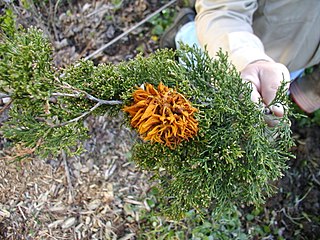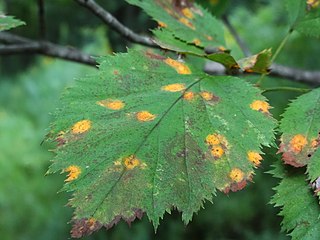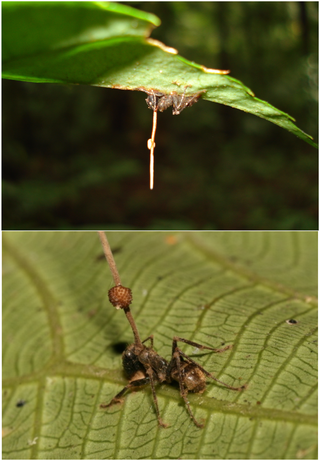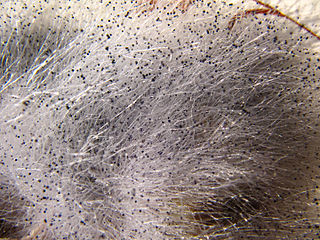
Gymnosporangium is a genus of heteroecious plant-pathogenic fungi which alternately infect members of the family Cupressaceae, primarily species in the genus Juniperus (junipers), and members of the family Rosaceae in the subfamily Amygdaloideae. The common name cedar-apple rusts has been used for these fungi. According to the Dictionary of the Fungi, there was 57 species in the genus. In 2023, Species Fungorum lists up to 74 species.

Rusts are fungal plant pathogens of the order Pucciniales causing plant fungal diseases.

Armillaria is a genus of fungi that includes the A. mellea species known as honey fungi that live on trees and woody shrubs. It includes about 10 species formerly categorized summarily as A. mellea. Armillarias are long-lived and form the largest living fungi in the world. The largest known organism covers more than 3.4 square miles (8.8 km2) in Oregon's Malheur National Forest and is estimated to be 2,500 years old. Some species of Armillaria display bioluminescence, resulting in foxfire.

Polypores are a group of fungi that form large fruiting bodies with pores or tubes on the underside. They are a morphological group of basidiomycetes-like gilled mushrooms and hydnoid fungi, and not all polypores are closely related to each other. Polypores are also called bracket fungi or shelf fungi, and they characteristically produce woody, shelf- or bracket-shaped or occasionally circular fruiting bodies that are called conks.

Armillaria mellea, commonly known as honey fungus, is an edible basidiomycete fungus in the genus Armillaria. It is a plant pathogen and part of a cryptic species complex of closely related and morphologically similar species. It causes Armillaria root rot in many plant species and produces mushrooms around the base of trees it has infected. The symptoms of infection appear in the crowns of infected trees as discoloured foliage, reduced growth, dieback of the branches and death. The mushrooms are edible but some people may be intolerant to them. This species is capable of producing light via bioluminescence in its mycelium.

Microsporidia are a group of spore-forming unicellular parasites. These spores contain an extrusion apparatus that has a coiled polar tube ending in an anchoring disc at the apical part of the spore. They were once considered protozoans or protists, but are now known to be fungi, or a sister group to fungi. These fungal microbes are obligate eukaryotic parasites that use a unique mechanism to infect host cells. They have recently been discovered in a 2017 Cornell study to infect Coleoptera on a large scale. So far, about 1500 of the probably more than one million species are named. Microsporidia are restricted to animal hosts, and all major groups of animals host microsporidia. Most infect insects, but they are also responsible for common diseases of crustaceans and fish. The named species of microsporidia usually infect one host species or a group of closely related taxa. Approximately 10 percent of the species are parasites of vertebrates —several species, most of which are opportunistic, can infect humans, in whom they can cause microsporidiosis.

Beech bark disease is a disease that causes mortality and defects in beech trees in the eastern United States, Canada and Europe. In North America, the disease occurs after extensive bark invasion by Xylococculus betulae and the beech scale insect, Cryptococcus fagisuga. Through a presently unknown mechanism, excessive feeding by this insect causes two different fungi to produce annual cankers on the bark of the tree. The continuous formation of lesions around the tree eventually girdles it, resulting in canopy death. In Europe, N. coccinea is the primary fungus causing the infection. Infection in European trees occurs in the same manner as it does in North American trees. Though the disease still appears in Europe, it is less serious today than it once was.

Armillaria luteobubalina, commonly known as the Australian honey fungus, is a species of mushroom in the family Physalacriaceae. Widely distributed in southern Australia, the fungus is responsible for a disease known as Armillaria root rot, a primary cause of Eucalyptus tree death and forest dieback. It is the most pathogenic and widespread of the six Armillaria species found in Australia. The fungus has also been collected in Argentina and Chile. Fruit bodies have cream- to tan-coloured caps that grow up to 10 cm (4 in) in diameter and stems that measure up to 20 cm (8 in) long by 1.5 cm (1 in) thick. The fruit bodies, which appear at the base of infected trees and other woody plants in autumn (March–April), are edible, but require cooking to remove the bitter taste. The fungus is dispersed through spores produced on gills on the underside of the caps, and also by growing vegetatively through the root systems of host trees. The ability of the fungus to spread vegetatively is facilitated by an aerating system that allows it to efficiently diffuse oxygen through rhizomorphs—rootlike structures made of dense masses of hyphae.

Chondrostereum purpureum is a fungal plant pathogen which causes Silver leaf disease of trees. It attacks most species of the rose family Rosaceae, particularly the genus Prunus. The disease is progressive and often fatal. The common name is taken from the progressive silvering of leaves on affected branches. It is spread by airborne spores landing on freshly exposed sapwood. For this reason cherries and plums are pruned in summer, when spores are least likely to be present and when disease is visible. Silver Leaf can also happen on poming fruits like apples and pears. Plums are especially vulnerable.

Gymnosporangium clavipes is a plant pathogen, a fungus that causes cedar-quince rust. Similar to Gymnosporangium juniperi-virginianae and Gymnosporangium globosum, the fungus infects a wide range of Rosaceae, such as apple, hawthorn and quince trees, and also requires an evergreen host such as eastern red cedar or a number of other juniper species to complete its life cycle.

Gymnosporangium globosum is a fungal plant pathogen that causes cedar-hawthorn rust.

Gymnosporangium juniperi-virginianae is a plant pathogen that causes cedar-apple rust. In virtually any location where apples or crabapples (Malus) and eastern red cedar coexist, cedar apple rust can be a destructive or disfiguring disease on both the apples and cedars. Apples, crabapples, and eastern red cedar are the most common hosts for this disease. Similar diseases can be found on quince and hawthorn and many species of juniper can substitute for the eastern red cedars.

Gymnosporangium sabinae is a species of rust fungus in the subdivision Pucciniomycotina. Known as pear rust, European pear rust, or pear trellis rust, it is a heteroecious plant pathogen with Juniperus sabina as the main primary (telial) host and Pyrus communis as the main secondary (aecial) host.

Ophiocordyceps unilateralis, commonly known as zombie-ant fungus, is an insect-pathogenic fungus, discovered by the British naturalist Alfred Russel Wallace in 1859, and currently found predominantly in tropical forest ecosystems. O. unilateralis infects ants of the tribe Camponotini, with the full pathogenesis being characterized by alteration of the behavioral patterns of the infected ant. Infected hosts leave their canopy nests and foraging trails for the forest floor, an area with a temperature and humidity suitable for fungal growth; they then use their mandibles to attach themselves to a major vein on the underside of a leaf, where the host remains after its eventual death. The process, leading up to mortality, takes 4–10 days, and includes a reproductive stage where fruiting bodies grow from the ant's head, rupturing to release the fungus's spores. O. unilateralis is, in turn, also susceptible to fungal infection itself, an occurrence that can limit its impact on ant populations, which has otherwise been known to devastate ant colonies.

Armillaria ostoyae is a species of fungus (mushroom), pathogenic to trees, in the family Physalacriaceae. In the western United States, it is the most common variant of the group of species under the name Armillaria mellea. A. ostoyae is common on both hardwood and conifer wood in forests west of the Cascade Range in Oregon, United States. It has decurrent gills and the stipe has a ring. The mycelium invades the sapwood and is able to disseminate over great distances under the bark or between trees in the form of black rhizomorphs ("shoestrings"). In most areas of North America, Armillaria ostoyae can be separated from other species by its physical features: cream-brown colors, prominent cap scales, and a well-developed stem ring distinguish it from other Armillaria. Like several other Armillaria, the mycelium of Armillaria ostoyae can display bioluminescence, resulting in foxfire.

Telium, plural telia, are structures produced by rust fungi as part of the reproductive cycle. They are typically yellow or orange drying to brown or black and are exclusively a mechanism for the release of teliospores which are released by wind or water to infect the alternate host in the rust life-cycle. The telial stage provides an overwintering strategy in the life cycle of a parasitic heteroecious fungus by producing teliospores; this occurs on cedar trees. A primary aecial stage is spent parasitizing a separate host plant which is a precursor in the life cycle of heteroecious fungi. Teliospores are released from the telia in the spring. The spores can spread many kilometers through the air, however most are spread near the host plant.

Amylostereum is the single genus in the fungal family Amylostereaceae. The genus currently comprises four saprotrophic and parasitic species, which live off living or dead wood. The Amylostereaceae cause white rot in the wood by disintegrating the tissue component lignin. They produce crust-like, partially wavy fruit bodies on the surface of infested trees, which are similar to those produced by Stereum species.

Heterobasidion irregulare is a tree root rotting pathogenic fungus that belongs to the genus Heterobasidion, which includes important pathogens of conifers and other woody plants. It has a wide host and geographic range throughout North America and causes considerable economic damage in pine plantations in the United States. This fungus is also a serious worry in eastern Canada. Heterobasidion irregulare has been introduced to Italy (Lazio)(modifica) where it has been responsible for extensive tree mortality of stone pine. Due to the ecology, disease type, host range/preference, interfertility group, and genetic information, H. irregulare was designated a new species and distinguished from Heterobasidion occidentale.
The foamy bark canker is a disease affecting oak trees in California caused by the fungus Geosmithia sp. #41 and spread by the Western oak bark beetle. This disease is only seen through the symbiosis of the bark beetles and the fungal pathogen. The bark beetles target oak trees and bore holes through the peridermal tissues, making tunnels within the phloem. The fungal spores are brought into these tunnels by the beetles and begin to colonize the damaged cells inside the tunnels. Symptoms of the developing fungus include wet discoloration seeping from the beetle entry holes as the fungus begins to consume phloem and likely other tissues. If bark is removed, necrosis of the phloem can be observed surrounding the entry hole(s). As the disease progresses, a reddish sap and foamy liquid oozes from entry holes, thus giving the disease the name foamy bark canker. Eventually, after the disease has progressed, the tree dies. This disease is important because of its detrimental effects on oak trees and its ability to spread to several new Californian counties in just a couple of years.

Rhizopus stolonifer is commonly known as black bread mold. It is a member of Zygomycota and considered the most important species in the genus Rhizopus. It is one of the most common fungi in the world and has a global distribution although it is most commonly found in tropical and subtropical regions. It is a common agent of decomposition of stored foods. Like other members of the genus Rhizopus, R. stolonifer grows rapidly, mostly in indoor environments.




















